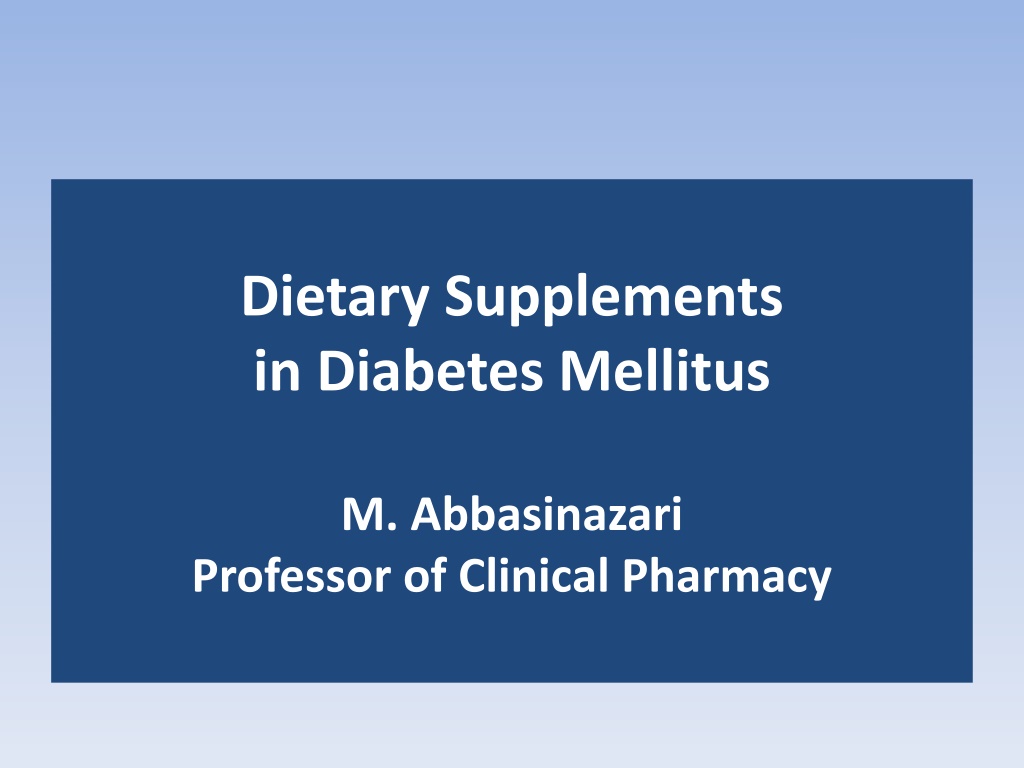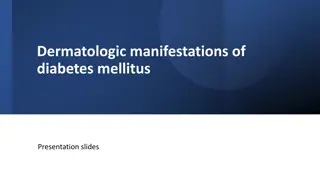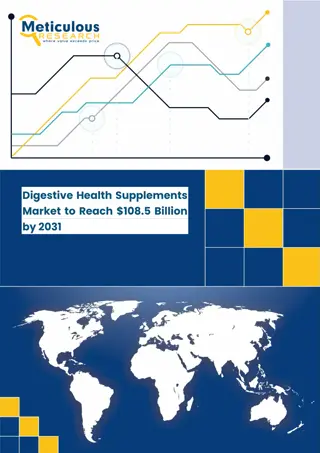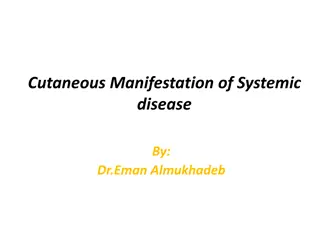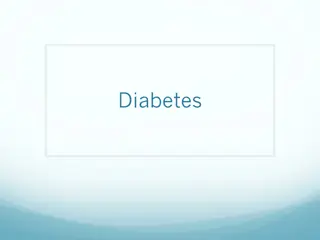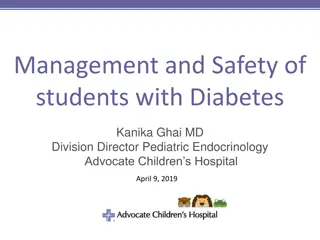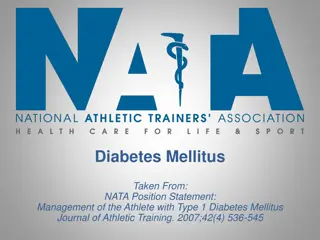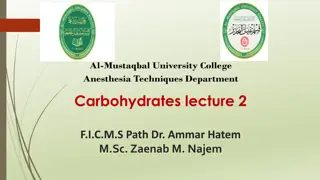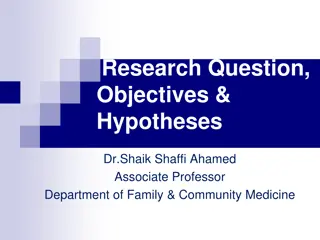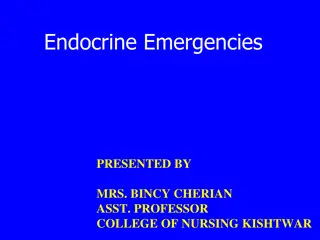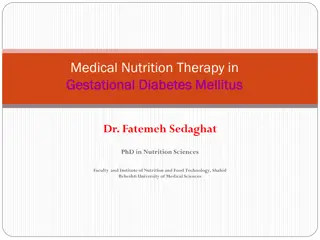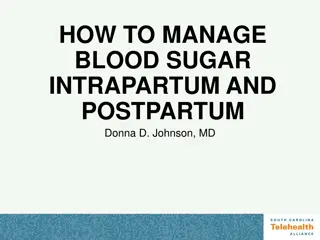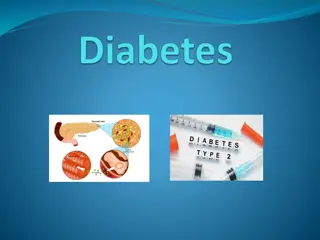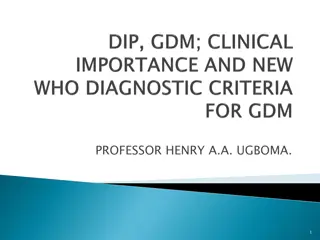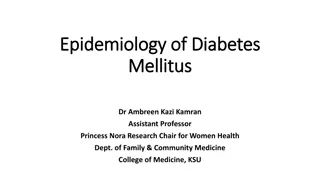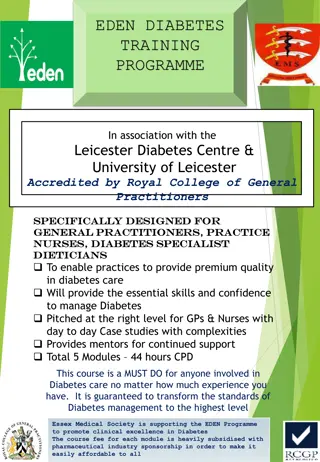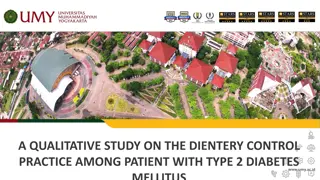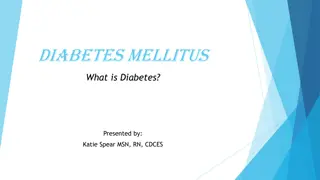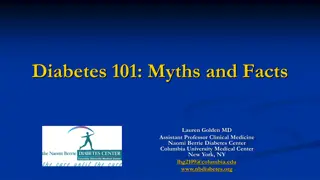Understanding Dietary Supplements in Diabetes Mellitus
Explore the role of dietary supplements in managing diabetes mellitus, covering principles, complementary medicine, functional foods, history, regulations, and the definition of dietary supplements. Learn about the benefits and considerations of using supplements as a part of diabetes management.
Download Presentation

Please find below an Image/Link to download the presentation.
The content on the website is provided AS IS for your information and personal use only. It may not be sold, licensed, or shared on other websites without obtaining consent from the author. Download presentation by click this link. If you encounter any issues during the download, it is possible that the publisher has removed the file from their server.
E N D
Presentation Transcript
Dietary Supplements in Diabetes Mellitus M. Abbasinazari Professor of Clinical Pharmacy
Content principles Supplementary in DM
Complementary medicine Dietary Supplements 3
Terminology Functional Foods Any modified food or ingredient that may provide a benefit beyond the traditional nutrients it contains Phytochemicals Such foods that are derived from naturally occurring ingredients 4
Dietary Supplements Alternative therapies and natural remedies Dietary supplements = 6.5 billion / Prescription Drug sales = 85 billion Increased consumer dissatisfaction with conventional health care of US population use Dietary Supplements 5
History of Dietary Supplements 1938 Act established standards of identity for vitamins and minerals Proxmire Amendments extended FDA jurisdiction to advertising of Vits and mins Prohibited FDA from setting max limits on potency Forbade FDA from classifying supplements as drugs 6
History of Dietary Supplements 1994 President Clinton signed Dietary Supplement, Health and Education Act (DSHEA) into law 7
DSHEA Created Office of Dietary Supplements within National Institute of Health (NIH) Permits statements of nutritional support including structure and function claims After passage of DSHEA, sales increased to 13 billion per year. 8
What is a Dietary Supplement? Definition: A productintended to supplement the diet that bears or contains one or more of the following dietary ingredients Vitamins Minerals Herbs or other botanicals Amino acids Concentrate, metabolite, constituent, extract or combination of above listed ingredients 10
Dietary Supplements These products are taken by mouth. These products are found in many forms to include: Tablets Capsules Softgels Gelcaps Liquids Powders Bars
Dietary Supplements Distinguished from Drugs: Drug = article intended to diagnose, cure, mitigate, treat, or prevent disease Both intended to affect structure and function of body Drug must undergo FDA approval after clinical studies to determine effectiveness and safety 12
Labeling of Dietary Supplements DSHEA authorized to provide accurate information to consumers Label must include: Name of each ingredient Quantity of each ingredient Total weight of all ingredient if a blend Identity of part of plant derived from Term Dietary Supplement Must contain nutritional labeling information also Calories, fat, sodium 13
According to the ADA, the primary approach to controlling DM involves diet and lifestyle modification combined with pharmacologic intervention. The ADA purports that herbal and dietary supplements lack Evidence to substantiate use in DM. Despite this, the use of natural products and dietary supplements to help control DM has become increasingly popular. In US 29,000 nutritional supplements are available to consumers, accounting for approximately US$12 billion in annual spending in the US.
Nicotinamide Fenugreek Cinnamon Ginseng Chromium Bitter Melon Vitamin D
Nicotinamide Nicotinamide (also referred to as niacin, vitamin B3, and nicotinic amide) is a water-soluble vitamin B derivative that may bolster the release of C-peptide and insulin. These factors may help reserve residual beta-cell function in patients with newly diagnosed type 1 diabetes.
Although it is most frequently used in high doses for treating hyperlipidemia studies suggest that prolonged use may prevent the onset of DM.
New Zealand study in school children aged 5 to 8 years Duration :about 7 years 16.07 vs 7.14 per 100000 person per year in two groups Adverse Drug Reactions
It is a widely used herb in many countries including India, China, Egypt, and the Middle East. Although commonly used in cooking, it is often used in patients with DM, especially for those with limited health-care access.
In animal studies, fenugreek has shown a potential reduction in glucose absorption in the GI tract, as well as slower digestion of carbohydrates via enzymes High content of dietary fiber and pectin in fenugreek which are responsible for slowing the GI transit. Fenugreek seeds also contain free amino acids, which have the potential to stimulate insulin release in the presence of elevated glucose concentrations
Evidence Studies indicate reduction in HbA1C levels as well as postprandial glucose and fasting glucose Inconclusive evidence of recommended doses
ADRs Dyspepsia, mild abdominal distension, stomach discomfort, and nausea Increased risk of bleeding with concomitant antiplatelet and anticoagulant agents Potentially oxytocic
Cinnamon is a widely used spice that is hypothesized to improve glucose control by phosphorylating insulin receptor tyrosine kinase which increases insulin sensitivity. In addition, cinnamon extracts have been implicated in the production of transcription factors that modify insulin resistance through possible modulation of GLUT4 transporters involved with mobilizing glucose into the cell
A 2013 meta-analysis reviewed 10 randomized control trials a total of 543 participants. The results revealed that cinnamon, compared to control, resulted in statistically significant reductions in FPG, LDL and total cholesterol The analysis failed to determine a statistically significant difference in HbA1C Reductions in FPG (24.5 mg/dL) are less than those achieved by metformin monotherapy (58 mg/dL) and somewhat more than the newer agents, such as sitagliptin (16 to 21 mg/dL).
There were many inconsistencies between studies in the analysis Dose: 6 to 120 mg/d Kind of cinnamon: Cinnamon cassia, the most commonly used and inexpensive formulation of cinnamon& coumarin Cinnamon zeylanicum has far less coumarin and is thought to be more effective in diabetes
ADRs Liver dysfunction
Summary The effects of cinnamon on the reduction in glucose levels are documented but lack reproducible data to encourage widespread use. Larger, long-term trials with consistencies in product formulation, potency, and subject baseline characteristics are warranted before any recommendations can be made
Mechanism The roots of North American and Eastern Asian ginseng (common forms of ginseng) have long been used in diabetes. Active constituents of ginseng roots include ginsenosides and possibly polysaccharides, which are thought to reduce PPG Reduce post prandial glucose levels by either tissue insulin sensitization and/or direct stimulation of insulin release
Evidence Most regarding American instead of Asian Results in reduction of fasting blood glucose Long-term evidence with substantial study size lacking Optimal daily dosing unknown
ADRs GI: Dyspepsia, constipation Hot flashes Insomnia Decreases effectiveness of warfarin
Chromium is a trace element obtained in the diet through foods such as fish, meat, whole-grain cereals, and nuts. On average, Americans obtain between 25 and 33 mg of dietary chromium a day, well below the recommended daily allowance of 50 to 200 mg
Benefit in DM Prolongs action of the insulin receptor; allows longer stimulation of the insulin receptor and up regulation of insulin receptor
Evidence Mixed results due to poor study designs and low sample sizes A 2004 review of 21 studies demonstrated no significant differences in placebo versus chromium supplementation in terms of reducing HbA1C, FPG, or OGTT. A major contributing factor was that many of these studies were poorly designed; 1/3 of the available data were open-label trials subject to participant bias. Sample sizes were small, with under 30 participants in most studies, and were short term in nature; the longest trial duration was 10 months.
ADRs Isolated reports of kidney and liver function impairment
It is consumed as a vegetable in countries such as India and Asia. The fruit and seeds are the parts thought to help diabetes control Theoretical mechanisms include insulin-like properties, glucose uptake, decreased hepatic gluconeogenesis, increased peripheral glucose oxidation, and inhibition of enzymes involved in glucose production
